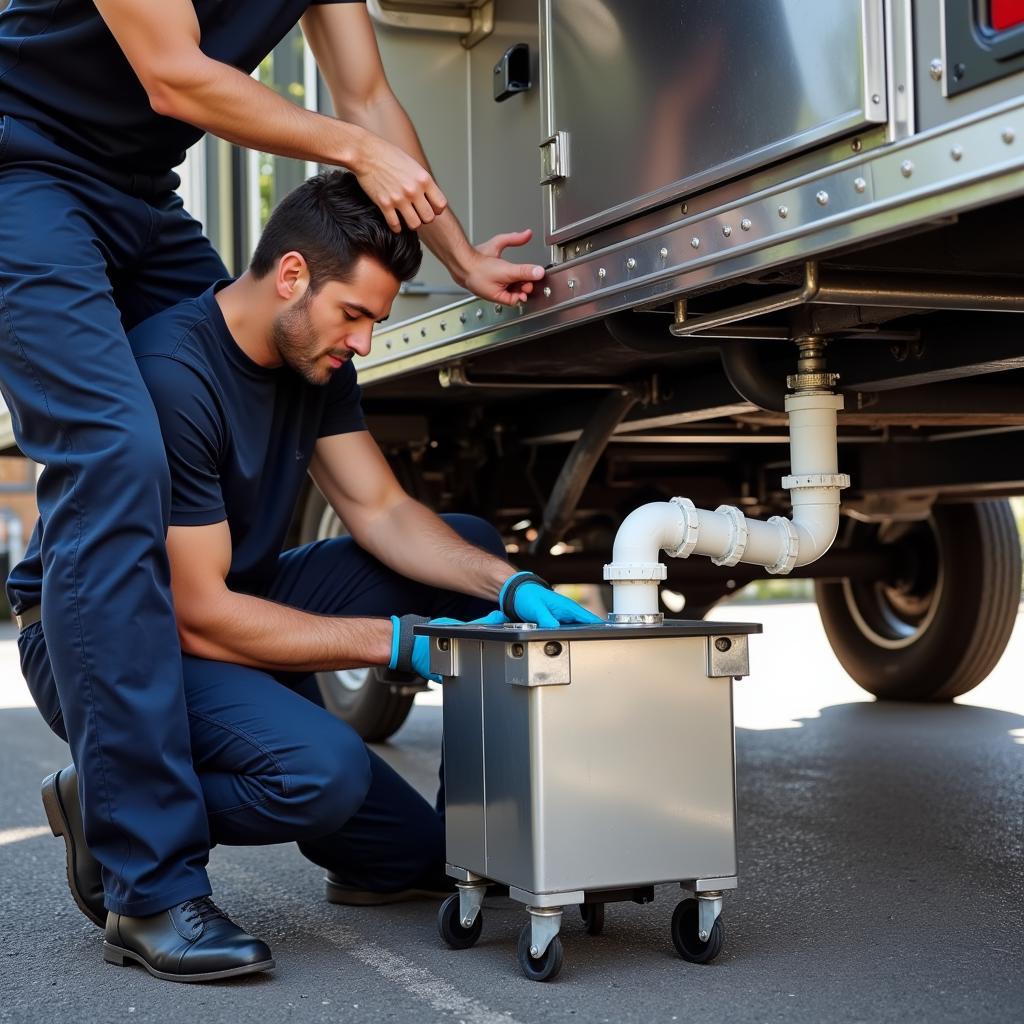Owning a food truck is a dream for many aspiring culinary entrepreneurs. The allure of serving delicious food on the go, meeting new people, and being your own boss is undeniable. However, amidst the excitement of creating mouthwatering menus and designing your dream truck, there’s a crucial aspect that often gets overlooked – grease management. This is where a Grease Trap For Food Truck comes into play.
Why Grease Traps are Non-Negotiable for Food Trucks
Imagine this – you’re in the middle of a busy lunch rush, serving up a storm of juicy burgers and crispy fries. Unbeknownst to you, fats, oils, and grease (FOG) are quietly wreaking havoc in your plumbing system. Without a proper grease trap, FOG solidifies and accumulates in your pipes, leading to:
- Clogged drains: This can bring your food truck operations to a grinding halt, costing you time, money, and frustrated customers.
- Foul odors: Nobody wants their delicious food experience tainted by unpleasant smells emanating from clogged drains.
- Health code violations: Health inspectors take grease management seriously, and violations can result in hefty fines or even closure.
- Environmental damage: Improperly disposed FOG can pollute waterways and harm wildlife.
 Food Truck Grease Trap Installation
Food Truck Grease Trap Installation
Choosing the Right Grease Trap for Your Food Truck
Selecting the appropriate grease trap is crucial for efficient FOG management. Here’s what you need to consider:
1. Size Matters
Grease traps are sized based on the flow rate of your sinks and the volume of wastewater generated. Consult with a plumbing professional to determine the right size for your specific needs.
2. Types of Grease Traps
- Passive Grease Traps: These are the most common type for food trucks, relying on gravity to separate FOG from wastewater.
- Automatic Grease Interceptors: These units use mechanical or electrical components to remove FOG more efficiently, ideal for high-volume food trucks.
3. Space Constraints
Food trucks have limited space, so choose a compact and efficient grease trap that fits your layout without compromising functionality.
Grease Trap Maintenance: A Must for Food Truck Success
Installing a grease trap is just the first step. Regular maintenance is crucial to ensure its effectiveness and longevity.
1. Daily Scraping:
Remove food scraps and debris from the trap daily to prevent build-up and odors.
2. Regular Pumping:
Hire a licensed waste hauler to pump and dispose of the collected FOG. The frequency depends on your usage, but it’s generally recommended every 1-3 months.
3. Professional Cleaning:
Schedule a thorough cleaning by a professional at least once a year to remove hardened grease and ensure optimal performance.
Grease Traps: An Investment Worth Making
While investing in a grease trap might seem like an additional expense, it’s a small price to pay for the long-term benefits it provides:
- Uninterrupted Operations: Avoid costly downtime caused by plumbing issues.
- Compliance with Regulations: Stay on the right side of health codes and avoid penalties.
- Enhanced Reputation: Maintain a clean and hygienic food truck, attracting more customers.
- Environmental Responsibility: Do your part in protecting the environment by properly disposing of FOG.
FAQs about Grease Traps for Food Trucks
1. Can I install a grease trap myself?
While it’s tempting to save money, it’s highly recommended to hire a licensed plumber for installation to ensure proper connections and code compliance.
2. How often should I have my grease trap pumped?
The pumping frequency depends on your food truck’s usage and the type of grease trap installed. A general rule of thumb is every 1-3 months.
3. What are the signs of a clogged grease trap?
Slow draining sinks, gurgling sounds in the plumbing, and foul odors are all telltale signs of a clogged grease trap.
4. Can I pour hot water down the drain to dissolve grease?
While hot water might temporarily liquefy grease, it will solidify again further down the pipes, exacerbating the problem.
5. Are there eco-friendly grease trap options available?
Yes, some companies offer grease recycling services, where the collected FOG is converted into biofuel or other useful products.
Don’t Let Grease Derail Your Food Truck Dreams
A grease trap is an indispensable investment for any food truck owner serious about success. By understanding the importance of grease management and implementing proper maintenance practices, you can ensure smooth sailing for your culinary venture. Remember, a well-maintained grease trap is a recipe for a thriving and compliant food truck business.
For more information on essential food truck equipment, check out our guides on food trailer appliances and vent hood for food truck.
Need expert advice on choosing the right grease trap for your food truck? Contact us at 02437655121, email us at [email protected], or visit us at 3PGH+8R9, ĐT70A, thôn Trung, Bắc Từ Liêm, Hà Nội, Việt Nam. Our dedicated team is available 24/7 to assist you.